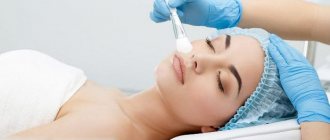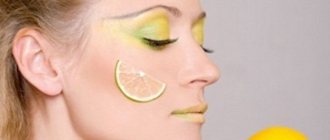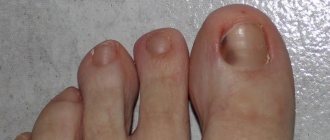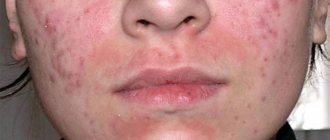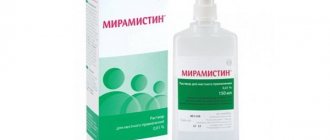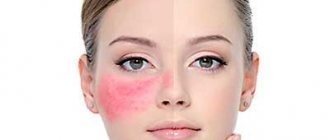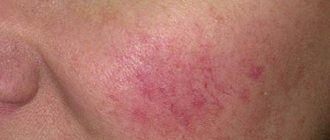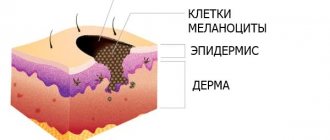Rosacea is a fairly common progressive dermatological disease, accompanied by the development of an inflammatory process in the sebaceous glands and the appearance of rosacea and rosacea on the skin.
Since the rash elements are localized on the face, the problem becomes not only medical, but also aesthetic. People who are faced with the disease have to lead a reclusive lifestyle until the pathology disappears.
There are many reasons for the development of the disease. And before you start using a certain method of therapy, you should consult a specialist and undergo an examination. Rosacea therapy is a labor-intensive and lengthy process. Only with a competent and comprehensive approach, including the use of medications, lifestyle and nutrition correction (diet), as well as laser treatment for rosacea, will it be possible to get rid of the disease.
The disease is characterized by inflammation and infection of the dermis, redness of the skin, the appearance of acne, tubercles and purulent pimples, as well as vasodilation and the appearance of telangiectasia - red vascular network, eye damage (soreness, sensation of a foreign body), burning, itching and tightening of the dermis.
Absolutely anyone can experience this disease. However, according to statistical data, the appearance of rosacea and all accompanying symptoms is more often diagnosed in people over 40 years of age. The disease in older people is often complicated by rhinophyma.
The occurrence of the disease may be due to:
- genetic predisposition;
- lifestyle features;
- abuse of spicy, smoked, salty and fried foods;
- excessive consumption of coffee, strong tea, alcoholic drinks, soda;
- frequent visits to the solarium and prolonged exposure to the sun;
- smoking;
- improper skin care or its complete absence;
- frequent stressful situations;
- taking hormonal contraceptive pills;
- the presence of chronic gastrointestinal pathologies (peptic ulcer, gastritis, duodenitis);
- the presence of autoimmune systemic diseases (rheumatoid arthritis, systemic lupus erythematosus);
- diabetes.
After identifying the main cause and clarifying the diagnosis, the doctor will prescribe treatment for the disease. Laser treatment for rosacea is often included in complex therapy. This method is highly effective and helps to quickly cure the disease.
The effectiveness of laser treatment
Laser therapy for skin pathologies is very effective and efficient.
The use of laser treatment for rosacea in combination with drug therapy promotes:
- eliminating redness;
- narrowing of blood vessels;
- disinfection of the affected area, creation of a sterile environment and destruction of fungi and bacteria;
- even out the color and surface of the skin;
- elimination of transient and diffuse redness;
- restoration of the structure of the skin;
- elimination of pathological formations (nodules and papules);
- targeted destruction of hypertrophied tissue;
- normalization of metabolic processes;
- preventing the emergence of new lesions;
- improving appearance and significantly improving quality of life.
Laser therapy for rosacea has many advantages over other methods.
The main ones include:
- painlessness;
- no need for anesthesia;
- short duration of the procedure;
- lack of special training;
- no need for hospitalization;
- minimal number of contraindications and complications;
- low cost.
How long does the result last?
The duration of the effect and durability of the result will depend on how well the patient adheres to the doctor’s recommendations, especially during recovery after laser exposure. In order to prevent the recurrence of the disease, it is necessary to follow a special diet, which involves avoiding the consumption of alcoholic beverages, sweet sodas, hot and spicy foods, and maintaining an exclusively healthy lifestyle. If the patient adheres to all the doctor’s recommendations, he is guaranteed to maintain the effect after therapy for up to three years.
Indications and contraindications
Laser therapy, in combination with drug treatment, will help get rid of the disease in the shortest possible time. Treatment of rosacea with a laser is carried out in the initial stages of the pathology and with extensive lesions. This technique is prescribed for people with rosacea on the cheeks, chin, neck, and forehead. The disease is also characterized by dilation of capillaries, which can be successfully treated with laser.
However, not everyone can be helped to get rid of the problem in this way, so the technique is not used for people suffering from:
- poor blood clotting;
- the presence of infectious pathologies;
- elevated temperature;
- diabetes;
- mental illness;
- epilepsy;
- tuberculosis;
- exacerbation of chronic ailments;
- acute inflammatory processes;
- skin ailments not related to rosacea - open wounds, rashes;
- tendency to form keloids;
- oncological pathologies.
Factors influencing the course and appearance of rosacea
Most often, women who are genetically prone to skin diseases suffer from rosacea. The disease usually manifests itself during hormonal changes in the body, for example, during menopause.
People at increased risk of developing rosacea include the following:
- representatives of the Caucasian race, especially those with red hair or albinos;
- patients with metabolic disorders, suffering from diabetes, hyper- or hypothyroidism;
- persons with chronic gastrointestinal diseases such as gastritis, duodenitis, ulcers, Crohn's disease, etc.;
- patients with systemic lupus erythematosus, rheumatoid arthritis and other autoimmune systemic diseases.
Also, very often the appearance of rosacea is associated with the presence of Demodex mites on the skin of the face.
In addition to the above reasons, there are some trigger factors that can trigger the development of the disease:
- frequent consumption of spicy and smoked foods, for example, Indian, Chinese and Mexican dishes;
- energy drinks, coffee, strong tea, alcohol;
- excessive insolation - prolonged exposure to direct rays of the sun or in solariums;
- taking hormonal medications, including birth control pills.
The appearance of so-called steroid acne can be caused by improper use of medicinal ointments and creams that contain synthetic steroids.
The essence of laser correction of rosacea
Modern medicine is rich in progressive methods of treating many diseases, including rosacea. Cosmetological correction occupies a special place in the development of advanced technologies and methods of treating various skin diseases. The most effective, popular and quite affordable is laser treatment for rosacea or rosacea.
It is carried out using directed waves of different lengths. Depending on the wavelength of light during laser irradiation, different effects on diseased tissue can be obtained.
In the case of treatment for rosacea, a local photothermal laser effect is applied to the area affected by rosacea, in which the energy is focused only within the inflamed areas of the skin, causing coagulation or, in other words, gluing of pathologically dilated blood capillaries. As a result of this procedure, the areas of redness become significantly lighter and inflammation stops.
How is the procedure performed?
Laser treatment is carried out on an outpatient basis and exclusively by a doctor who has the appropriate certificate, which gives the specialist the right to carry out such manipulations.
The air in the room in which the laser operates must be disinfected with a bactericidal lamp for 15 minutes before each patient is admitted.
Before starting the procedure, the doctor must wear sterile gloves, a mask, a cap and goggles. The patient must also wear special safety glasses.
The stages of laser correction for rosacea are as follows:
- Treating the face with an antiseptic solution. If the patient has very sensitive skin, it is recommended to lubricate the area that will be subjected to laser treatment with a special cooling cream. Most modern laser machines are already equipped with an automatic cooling system and no pre-lubrication of the face is required.
- Depending on the size of the acne-affected areas, the duration of the procedure can be from 8 to 15 minutes.
- Typically, laser therapy is painless. Sometimes patients may feel warm.
- After all affected areas have been treated with the laser, a special soothing cream is applied to the skin, and the patient can go home.
- Redness decreases within 3-4 hours.
In order to completely eliminate the defect, it is necessary to undergo several repeated procedures. The course of treatment is usually 2 months. The break between laser irradiations should be at least 7 days.
Important! 10 days before the scheduled procedure, you should stop using various creams, including foundations, masks, foams and, especially, facial scrubs.
To avoid possible complications and identify contraindications, the patient is prescribed the following tests:
- general blood and urine analysis;
- biochemical blood test with a standard set of liver and kidney tests, as well as inflammation indicators;
- blood test for hepatitis, HIV;
- blood for the Wasserman reaction - test for syphilis;
- coagulogram with determination of bleeding duration and blood clotting time.
In some cases, before laser therapy for rosacea, additional tests are prescribed, for example: determination of hormonal levels, x-ray and ultrasound examination of internal organs
Contraindications for laser treatment of rosacea
Like any other medical procedure, laser therapy also has indications and contraindications for its implementation. Despite the fact that the use of a laser is a fairly effective and reliable method of treating cosmetic defects, there are a number of pathological conditions in which it is prohibited to eliminate rosacea on the face using light waves:
- pregnancy and lactation;
- any acute inflammatory diseases;
- exacerbation of chronic diseases;
- diabetes;
- all forms of tuberculosis;
- neoplasms and oncopathology;
- hereditary pathologies of connective tissue with a tendency to excessive formation of colloidal scars;
- any bleeding disorders;
- mental disorders.
Laser therapy is also contraindicated for patients who have rashes in the area of rosacea caused by another disease, including damage to the integrity of the skin.
It is worth noting
Before the procedure, in order to exclude all possible contraindications, the patient is prescribed to undergo mandatory laboratory tests: general and clinical analysis of urine and blood, a blood clotting test and a test for hepatitis B, C, HIV and syphilis.
Laser treatment is quite often used in modern dermatology. This technique is effective and in demand. With its help you can get rid of a variety of pathological conditions, diseases and defects of the dermis.
Rehabilitation after laser therapy
After the epidermis has been exposed to the laser, it will naturally experience minor bruising and sensitivity for some time. During this period, the skin needs the best care and respect. For several weeks after the procedure, you should protect yourself from direct sunlight, avoid climate change and other temperature changes.
Remember! Exposure to ultraviolet light can lead to the appearance of age spots.
Since after correction the upper layer of skin overreacts to any irritants, it is necessary to refrain from using lotions and other cosmetics containing alcohol, as well as scrubs.
Symptoms of the disease
Rosacea, the symptoms of which are mild at first, progresses gradually. The disease begins with redness of the cheeks, which goes away after a few days. Then the redness appears again and lasts longer, and at the next stage it does not go away at all. In the initial stages (episodic erythema or diathesis rosacea), few go to the doctor and therefore make a serious mistake. Masking cosmetics, which are used to hide an aesthetic defect, not only do not solve the problem, but also aggravate the symptoms of the disease - the pathology becomes even more pronounced.
The next stage is the stage of papulopustular manifestations, characterized by the appearance of acne, bumps, papules, and purulent pimples. Pustular rashes gradually affect the entire face, chest area, and scalp.
If the disease progresses, the phymatoid stage of rosacea begins - the skin in some areas begins to thicken, resembling an orange peel with its bumpiness. Certain parts of the body, such as the forehead, ears and nose, may also become thicker. Nasal thickening is one of the most common complications, which occurs mainly in men.
Ocular rosacea or ocular rosacea requires special attention. The disease is accompanied by such ophthalmological pathologies as blepharitis, iritis, keratitis, conjunctivitis. With keratitis, due to clouding of the cornea, complete blindness can occur.
How long does the effect last?
Despite the fact that laser removal of rosacea is a fairly effective procedure, further maintenance of healthy skin depends entirely on the patient. Rubbing with frozen herbal decoctions will help maintain excellent complexion and elasticity of the skin.
Since in most cases the appearance of rosacea is caused by bad habits, lifestyle correction plays an important role in maintaining skin health:
- an orderly daily routine with active rest and sufficient sleep;
- a diet containing sufficient amounts of vitamins, microelements and beneficial nutrients;
- exclusion from the diet of too hot, spicy, smoked and fatty foods, as well as coffee and alcohol;
- the use of complex cosmetics and drugs against rosacea and skin hyperemia.
Compliance with the above conditions will help maintain the therapeutic effect of laser correction for several years.
Recovery period
Rehabilitation measures are aimed at protecting against relapses and complications. Heparin ointment is used to speed up the healing of bruises. It is allowed to cover up the consequences of the procedure with foundation and other cosmetics.
After manipulation, it is important to avoid factors that provoke exacerbation of pathology, such as:
- Prolonged exposure to sunlight.
- Excessive physical activity.
- Regular nervous tension.
- Temperature changes, hypothermia.
- The use of scrubs and alcohol-based preparations.
On this topic
- Pimples
Everything you need to know about subcutaneous acne
- Inna Viktorovna Zhikhoreva
- September 27, 2020
If you follow all the rules, the result of treatment therapy will be stable for about three years. To do this you need:
- Use face masks with natural ingredients.
- Wash with cold water.
- Select only high-quality cosmetics.
- Take preventive medications.
- Spend less time in the sun.
- Get a full night's rest and engage in regular physical activity.
In the absence of effect from laser treatment and constant exacerbations, it is advisable to examine the gastrointestinal tract. Digestive disorders often complicate the restoration of the skin. It is important to remember that laser therapy should be combined with taking antihistamines and anti-inflammatory drugs.
Bottom line
Rosacea is a rather insidious cosmetic problem that lasts for years. Creams, ointments, and medications can only help in the initial stages of the disease, but advanced forms of rosacea require more radical measures.
Laser correction will help get rid of dilated capillaries, redness and rashes in just a few sessions. But laser alone cannot solve the problem.
If you want to get rid of rosacea forever, review your diet, lead a healthy lifestyle, exercise, spend enough time outdoors and you will soon notice a significant improvement in the condition of your skin.

